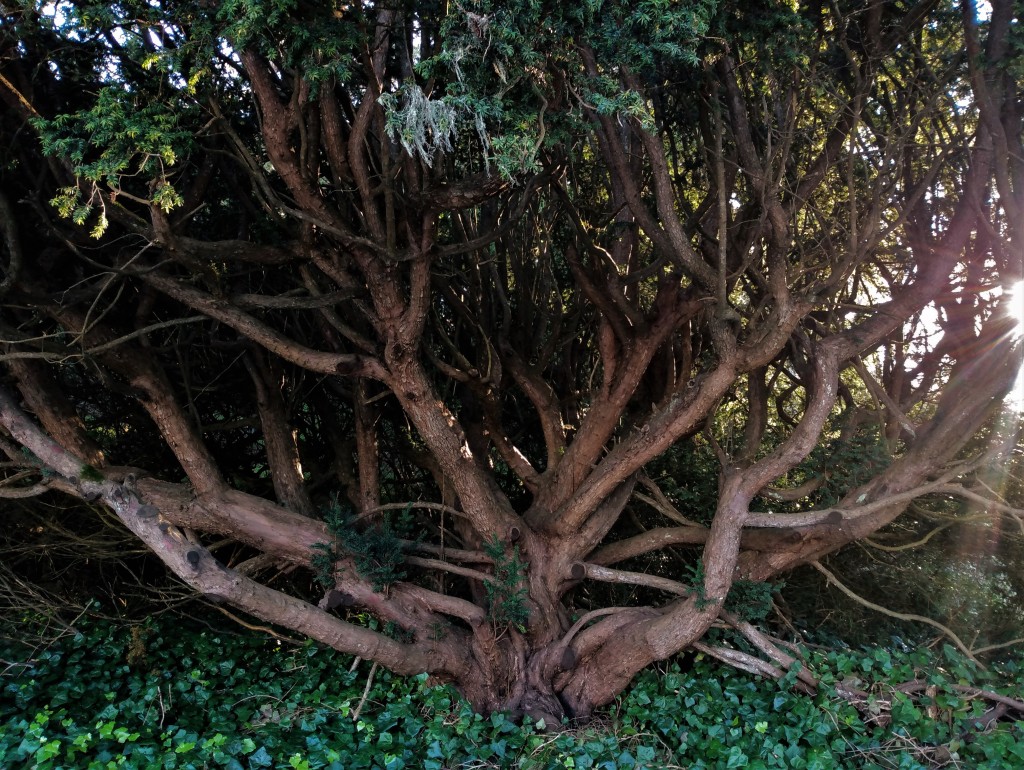I made up my own reading structure, which is borrowed from the arc of la pièce bien faite, the well-made play. There is a plot (rising action, culmination, falling action, and conclusion) and it is tightly and formulaically structured. However, runes are indirect and enigmatic, the exact opposite of a well-made play which delivers endings the audience expects. Runes don’t do that.
Depending on further contemplation, there might be other interpretations of this reading. But it’s early days yet, and I have all year. Quotes from all three rune poems, and the Prose and Poetic Eddas are italicized.
Reading from left
Ihwaz: a yew tree, old & venerable, with a thick trunk, gnarled branches and a root system that’s capable of penetrating stone. It is attacked by time and the elements, and is “the greenest in winter,” as the Norwegian rune poem points out, meaning it thrives even during the season of death. The yew stands solidly in churchyards, and also in Golden Gate Park where the San Francisco Call praised it. “One of the prettiest of the smaller trees are the specimens of the English yew, the same wood from which merry Robin Hood is said to have fashioned his bow. This tree is scarcely more than shrub here yet. It belongs to the genus Taxus and is a slow-growing, long-lived evergreen of moderate height and spread of branches. In Europe the yew is much used in graveyards.” The yew stands for thousands of years, doubled down into its strength and toughened by its resolve, a guardian of flame.
Tiwaz: the first appearance by a god in this reading. Did you know that Tyr took care of Fenrir, tenderly, like a parent? Only Tyr had the courage to approach it and feed it. When the wolf was bound, Tyr laid his right hand in the wolf’s mouth as surety. When the wolf realized his betrayal, he bit off the hand that fed him. All the gods laughed, except Tyr who understood what was at stake: the honor of the gods (honor is everything). Wrong action is met by right, and imbalance corrected when justice steps in. This action involves everyone.
Kenaz: it sits at the apex of this reading, as something inflamed, something that has collected itself fully to blaze forth, to erupt. Whether that causes a disgusting pimple, a painful lesion, or becomes a flame that provides warmth and light is one question. What caused it to combust? Did it emerge from Ihwaz, the tough old yew? What does it encourage? What does it expel?
Mannaz: it descends from Kenaz, which feels right; those who gather within a hall value the bright pale flame. There is a clear warning in the Anglo Saxon rune poem: every man is doomed to fail his fellow. To be beloved among kin is comforting (and in these days of pandemic surges, possibly hazardous.) Augmentation of earth; augmentation of dust. We were without fate once, inanimate, without vitality. We relish our illuminated/inflamed consciousness. But hubris may hound us. Awaken your fate.
Ansuz: (If you offer an invitation and hospitality, the gods will attend you.) Hail, Odin, All Father, ancestor, son of Bor, son of Buri and Bestla, giver of breath and life.
Dagaz: Either Nótt or Jörð gave birth to Day (or maybe Jörð was his sister), but he was as bright and beautiful as his father’s people. We have never stopped waiting for the sun to rise, (and have noted when it appears not to) to make his way through the sky with his horse Shining Mane. Dagr is beloved… a source of hope and happiness to rich and poor, and of service to all. What do we sing before his father’s doors? How glad is our song?
How completely does a new day put paid to the errors of the past?
Do you understand yet, or what more?


